- Author Matthew Elmers [email protected].
- Public 2023-12-16 21:49.
- Last modified 2025-01-24 09:17.
Argentina's first own submachine gun was created in the early thirties based on solutions spied on in foreign projects. Subsequently, in almost all new projects of this kind, they continued to use well-mastered and studied ideas. However, this approach led to certain limitations, which is why the military demanded to create a completely new design. A kind of revolution in the field of Argentine submachine guns was the FMK-3 product.
From the early thirties to the late fifties of the last century, the Argentine industry managed to create a number of its own submachine guns chambered for 9x19 mm "Parabellum" and.45 ACP. This weapon, in general, suited the military and the police, but over time it became obsolete. It showed acceptable performance, but was not very user-friendly. As a result, at the end of the sixties, the armed forces of Argentina demanded the creation of a new weapon of this class, which is fundamentally different from existing models.
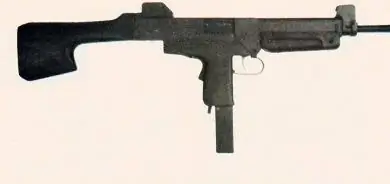
One of the experienced PA-3-DM submachine guns. Photo Thefirearmblog.com
From the available data, it follows that one of the main requirements for a promising submachine gun was to minimize its dimensions in a combat and transport position. From the point of view of other characteristics, the new model should at least not be inferior to the existing weapon. Unlike a number of previous projects, this time it was planned to create only one version of the submachine gun - chambered for 9x19 mm. Previously, it was used only by the army, but now the police have decided to switch to it.
It is known that several new projects of a submachine gun were submitted to the army's competition, one of which was developed by specialists from the Fábrica Militar de Armas Portátiles plant - Domingo Matheu (FMAP-DM) from Rosario. Previously, this enterprise produced the PAM-1 and PAM-2 submachine guns, which were a reworked version of the American M3 product. Thus, the plant had some experience in the field of light automatic weapons, which could be used in a new project.
The project from FMAP-DM received the working designation PA-3-DM: Pistola Ammetralladora (submachine gun) of the third model from Domingo Matheu. This designation remained until the moment of adoption and the launch of mass production. Submachine guns of a relatively small first production batch remained in history under the designation PA. Later, the weapon was renamed FMK-3. Later, new modifications of the product were created, the names of which resembled the last designation of the basic sample.

Serial FMK-3 with folding stock. Photo Zonwar.ru
All previous Argentine projects of submachine guns used the traditional arrangement of weapons with automatic weapons based on a free bolt, supported by a reciprocating mainspring at the rear, and a front-mounted magazine receiving shaft. This scheme made it possible to obtain the desired weapon, but imposed some restrictions. For this reason, some new ideas were proposed in the new project from FMAP-DM. It should be noted that they were new only for the Argentine weapons school, but not for foreign designers. Thus, the bolt for the PA-3-DM / FMK-3 to a certain extent resembled the assembly of the Israeli Uzi submachine gun. Perhaps it was about the direct borrowing of ideas and solutions, albeit with a certain revision before being introduced into your project.
FMAP-DM designers quickly formed the general appearance of the weapon and later only developed it. As a result, the production samples did not have any fundamental differences from the early prototypes. In all cases, a tubular receiver was used, supplemented by a T-shaped lower casing. The vertical pistol grip of the latter served as a magazine receiver. Early versions of the project suggested the use of a fixed stock, but later was abandoned in favor of a folding device.
All the main elements of automation had to be placed in the cylindrical upper part of the receiver. A metal tube of sufficient dimensions had a longitudinal slot in the front part on the left side. On the right, in the center, there was a window for ejection of cartridges. On the bottom of the tube, slots and windows were provided for supplying ammunition and supplying parts of the trigger mechanism. Under the tube, a stamped casing of the firing mechanism was fixed, made integral with the receiving shaft of the store. In the rear of such a casing there was a vertical element that covered the end of the receiver.
The FMK-3 submachine gun received a 9 mm rifled barrel, 290 mm long (32 caliber). The barrel was rigidly fixed in the front end of the receiver. A significant part of it was placed inside the box: the rear end of the chamber was located in line with the trigger. This placement of the barrel made it possible to significantly reduce the overall length of the weapon. The second method of reducing the size was associated with a non-standard design of the shutter.
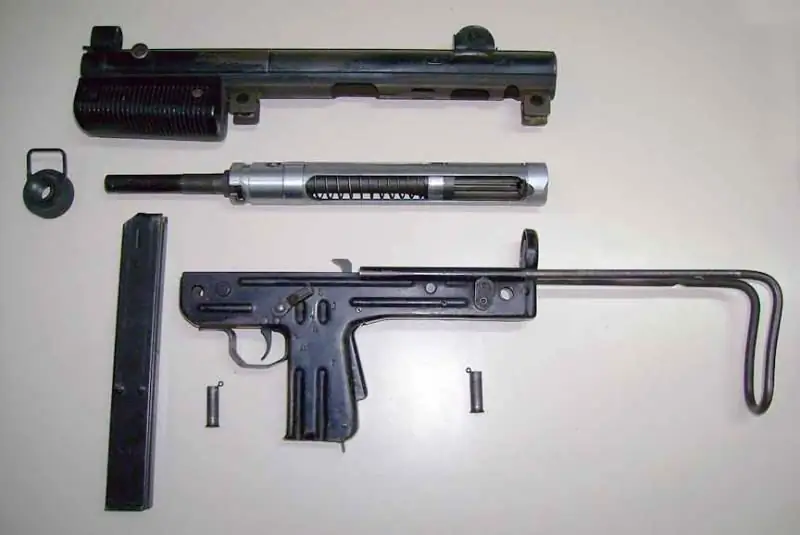
Incomplete disassembly of weapons. Photo Zonwar.ru
The weapon received automation based on a free shutter with the so-called. oncoming construction of the latter. The shutter was a large and massive cylindrical part with a significant internal cavity. The cup, which interacted with the cartridge and the breech of the barrel, was inside the bolt at some distance from its rear. The bolt had a fixed striker. When assembling a submachine gun, the barrel was placed inside the bolt. Being in the extreme forward position, the bolt overlapped the 180 mm barrel. Cocking was carried out using a handle brought out through the groove on the left. Shooting was carried out from an open bolt.
The barrel was locked by pressing the bolt to the chamber by the force of the reciprocating mainspring. The latter was put on the back of the barrel and placed inside the bolt. The front part of the spring was in contact with the corresponding bolt ring, the rear - with the extended outer surface of the breech.
The FMK-3 product was proposed to be equipped with a trigger mechanism of a relatively simple design, all parts of which were placed in the lower casing under the receiver. USM provided firing single or bursts. Fire control was carried out using a traditional trigger and a safety-translator flag, displayed above the hook on the left. The flag positions were indicated by embossed letters: S (Seguro - "safety"), R (Repetición - single) and A (Automático - automatic fire).
The manual fuse was supplemented with an automatic device. On the back of the handle there was a swinging key that was responsible for blocking or triggering the trigger. The key, not being pressed into the handle, did not allow firing.
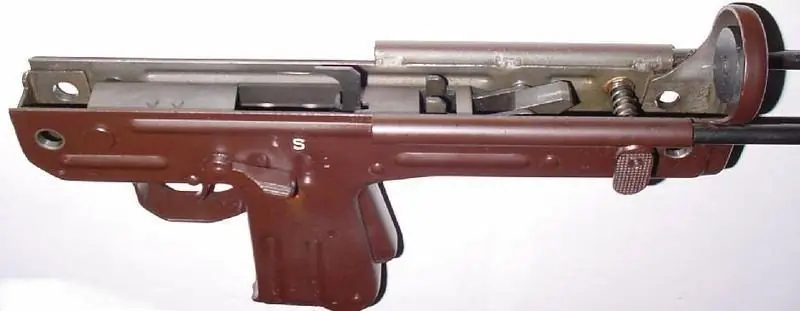
The insides of the weapon; the receiver is removed. Photo Sassik.livejournal.com
As the project developed, several store options were created. Stamped box-shaped devices accommodated 25, 32 or 40 cartridges of 9x19 mm "Parabellum" in their two-row arrangement. The store was placed inside the vertical pistol grip and was fixed with a spring-loaded latch. The latter was located on the bottom of the handle, directly behind the magazine.
Sights were not difficult. Above the front end of the receiver there was a front sight with height adjustment, covered with an annular front sight. On the back of the box was a U-shaped support with a swing-over whole. The apertures of the latter were designed for a range of 50 and 100 m.
Despite the simplified design, the PA-3-DM / FMK-3 submachine gun was distinguished by good ergonomics. It was proposed to hold the weapon by the pistol grip. Under the front of the receiver was a wooden or plastic forend. The first serial version of the weapon was equipped with a metal folding stock made of a long rod. The latter had a pair of longitudinal rods moving inside the tubes on the sides of the receiver, and a curved shoulder rest.
Also in the series were submachine guns, which differed from the base product in other accessories. The weapon could be equipped with a fixed wooden or plastic butt of a complex shape. The butt was installed on the rear of the receiver using a metal part that served as an additional cover.
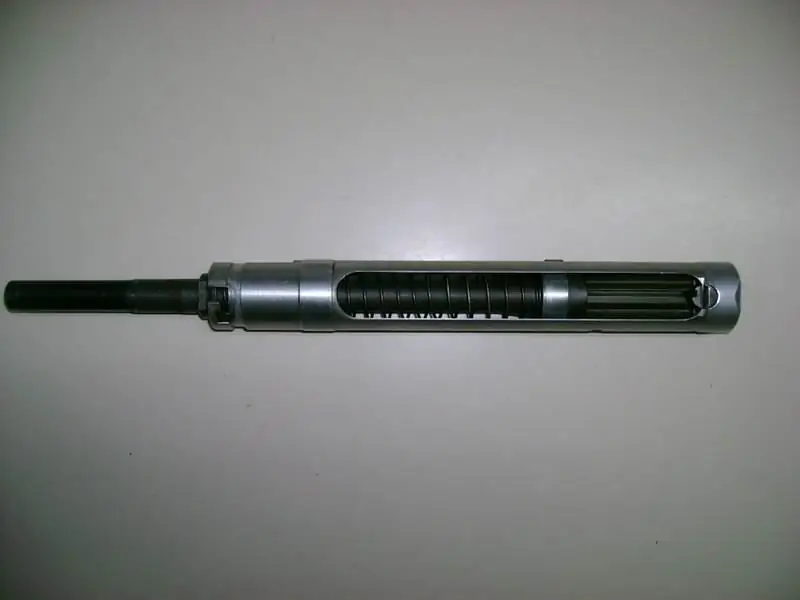
FMK-3 automation parts: outside (silver) - shutter. Inside it is a barrel and a reciprocating combat spring. Photo Sassik.livejournal.com
With a relatively long 290 mm barrel, the FMK-3 submachine gun with a folded stock was 520 mm long. The length with the butt extended reached 690 mm. The own weight of the weapon was 4.8 kg. The magazine with 40 rounds weighed another 500 g. The used automatic equipment made it possible to show the rate of fire at the level of 600-650 rounds per minute. The effective range of fire did not exceed 100-150 m, typical for automatic weapons chambered for a pistol cartridge.
The new FMK-3 submachine gun differed from its Argentine predecessors in the layout and design of the automation, which made it possible to obtain some advantages. So, the bolt running on the barrel made it possible to optimize the layout of the internal volumes. Recoil-fighting spring, put on the barrel, made it possible to reduce the length of the receiver. The unusual shape of the shutter led to a redistribution of the masses of the aggregates at the time of the shot, which reduced some of the impulses affecting the weapon, and to some extent increased the characteristics of accuracy and accuracy.
At the end of the sixties, the FMAP-DM enterprise consistently produced several prototypes of new weapons, differing in the design of certain parts. At the same time, the general scheme and basic decisions did not undergo major changes. By the beginning of the next decade, prototypes had passed the required tests and received customer approval. Soon there were orders for the adoption of the PA-3-DM into service with the army and police of Argentina.
According to known data, the first batch of PA-3-DM submachine guns, designated PA, was manufactured in 1970. The first batch consisted of 4500 items, the design of which was repeated later prototypes. This was followed by the first batch of several thousand serial FMK-3, equipped with fixed plastic stocks. A little later, it was decided to abandon the plastic and wooden stocks in favor of a folding wire structure. However, a few years later, an order for a weapon with a rigidly fixed butt appeared again. This time, to avoid confusion, the submachine gun was designated FMK-4. It differed from the basic FMK-3 only in fittings, retaining all the main devices and mechanisms.
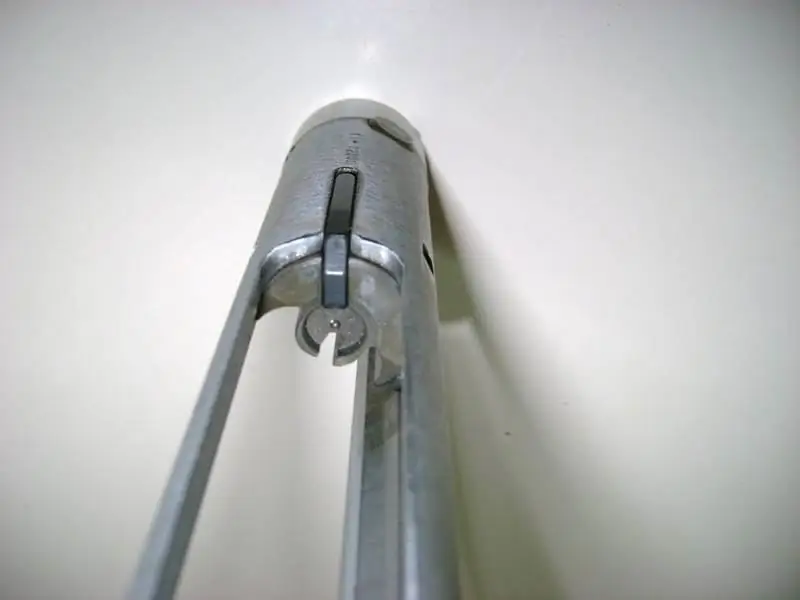
Shutter cup. Photo Sassik.livejournal.com
By the end of the seventies, amateur shooters began to show interest in such weapons. The consequence of this was the emergence of a new modification of the submachine gun. The product called FMK-5 was a complete copy of the FMK-4, equipped with different trigger controls. Unlike army and police models, civilian weapons did not have an automatic fire mode.
Distinguished by simplicity and low cost, submachine guns of the FMK-3 family quickly enough were able to become a mass weapon and enter service with many units from different structures. According to various sources, at least 30 thousand units of such weapons of all modifications were manufactured before the beginning of the eighties. Some sources give other figures - about 50 thousand. One way or another, the mass serial production of the FMK-3 made it possible to re-equip the army and law enforcement agencies, almost completely replacing the weapons of outdated models. In addition, the weapons in the version for the civilian market had a good effect on the earnings of the manufacturing company.
According to the available data, almost all contracts for the serial production of the FMK-3 were concluded with government agencies in Argentina. There was only one agreement with a foreign country. In the seventies, shortly after the start of the rearmament of Argentine units, FMK-3 products were adopted by Guatemala. Several thousand submachine guns were delivered to this country. The situation was similar with the civilian modification. She enjoyed some popularity in Argentina, but not in other countries.
Submachine guns of the FMK-3 family entered service in Argentina already in a relatively calm period, and therefore they were most often used at shooting ranges, as part of training activities for training personnel. However, according to various sources, the police and special services have repeatedly had to use such weapons in the fight against crime.
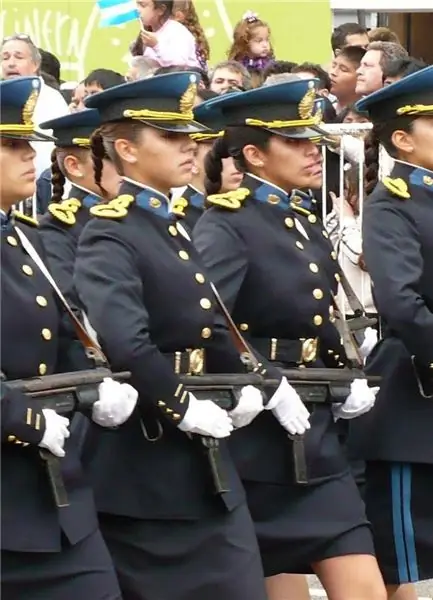
FMK-3s are still in operation and participate in various events. Photo Sassik.livejournal.com
The only armed conflict in the "biography" of army submachine guns was the war for the Falkland / Malvinas Islands. The Argentine soldiers had a variety of small arms at their disposal, including submachine guns from the FMAP-DM plant. It is known that a number of Argentine submachine guns went to the British as trophies. Now these weapons are kept in museums and private collections.
Despite their considerable age, the FMK-3 and FMK-4 submachine guns, as well as the civilian FMK-5 carbines, are still in service. Such a weapon shows sufficient characteristics, and besides, it did not have time to develop its resource. As a result, various parts of the armed forces and police structures still have a significant number of relatively old models. Over time, there was a partial replacement of these weapons with newer products, but its complete write-off is not yet planned.
Since the early thirties, Argentine gunsmiths have been engaged in the subject of submachine guns and over several decades have developed a number of interesting samples of such weapons. The FMK-3 project turned out to be the last in this series and may well be considered the pinnacle of the development of Argentine automatic weapons chambered for a pistol cartridge. As a result, the FMK-3 and its modifications remain in service with various units and are in no hurry to give up their place. In addition, for four decades Argentina has not tried to create a new submachine gun to replace existing weapons.






